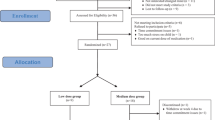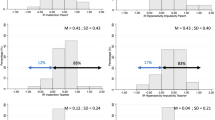Abstract
Thirteen children (ages 5.6 to 11.2 years) with autism and symptoms of attention-deficit hyperactivity disorder (ADHD) participated in a double-blind, placebo-controlled crossover study of methylphenidate (0.3 and 0.6 mg/kg per dose). Eight subjects responded positively, based upon a minimum 50% decrease on the Conners Hyperactivity Index. Ratings of stereotypy and inappropriate speech, which are often associated with autistic core features, also decreased. However, no changes were found on the Child Autism Rating Scale, a global assessment of autistic symptomotology. Significant adverse side effects occurred in some children including social withdrawal and irritability, especially at the 0.6 mg/kg dose. Results suggest that methylphenidate can be efficacious for children with autism and ADHD symptoms. However, this group of children seems to be particularly susceptible to adverse side effects.
Similar content being viewed by others
REFERENCES
Aman, M. G. (1996). Stimulant drugs in the developmental disabilities revisited. Journal of Developmental and Physical Disabilities, 4, 347–366.
Aman, M. G., Van Bourgondien, M. E., Wolford, P., & Sarphare G. (1995). Psychotropic and anticonvulsant drugs in subjects with autism: Prevalence and patterns of use. Journal of the American Academy of Child and Adolescent Psychiatry, 34, 1672–1681.
Aman, M. G., & Singh, N. (1986). The Aberrant Behavior Checklist. East Aurora, NY: Slosson.
American Psychiatric Association. (1994). Diagnostic and statistical manual of mental disorder (4th ed.). Washington, DC: Author.
Barkley, R. A. (1990). Attention-deficit hyperactivity disorder: A handbook for diagnosis and treatment. New York: Guilford.
Birmaher, B., Quintana, H., & Greenhill, L. (1987). Methylphenidate treatment of hyperactive autistic children. Journal of the American Academy of Child and Adolescent Psychiatry, 26, 248–251.
Burack, J. A., Ennis, J. T., & Johannes, E. A. (1997). Attention and autism: Behavioral and electrophysiological evidence. In D. J. Cohen & F. R. Volkmar (Eds.), Handbook of autism and pervasive developmental disorder (2nd ed., pp. 226–247). New York: Wiley.
Campbell, M., Fish, B., David, R., Shapiro, T., Collins, P., & Koh, C. (1972). Response to tri-iodothyronine and dextoamphetamine: A study of preschool schizophrenic children. Journal of Autism and Childhood Schizophrenia, 2, 343–358.
Campbell, M., Small, A. M., Collins, P. J., Friedman, E., David, R., & Genieser, N. (1976). Levodopa and levoamphetamine: A crossover study in young schizophrenic children. Current Therapy Research, 19, 70–86.
Collier, R. O., Baker, F. B., Mandeville, G. K., & Hoyes, T. F. (1972). Estimates of test size for several test procedures based on conventional variance ratios in the repeated measures design. Psychometrika, 37, 339–353.
Davidson, M. L. (1972). Univariate versus multivariate tests in repeated measures experiments. Psychological Bulletin, 77, 446–452.
Denckla, M. B., Bemporad, J. R., & MacKay, M. C. (1976). Tics following methylphenidate administration. Journal of the American Medical Association, 235, 1349–1351.
DuPaul, G. J., & Barkley, R. A. (1990). Medication therapy. In R. A. Barkley (ed.), Attention-deficit hyperactivity disorder: A handbook for diagnosis and treatment (pp. 573–612). New York: Guilford.
Elia, J., Borcherding, B. G., Rapport, J. L., & Keysor, C. S. (1991). Methylphenidate and dextroamphetamine treatments of hyperactivity: Are there true non-responders? Psychiatry Research, 36, 141–155.
Geller, B., Guttmacher, L. B., & Bleeg, M. (1981). Coexistence of childhood onset pervasive developmental disorder and attention deficit disorder with hyperactivity. American Journal of Psychiatry, 138, 388–389.
Goyette, C. H., Conner, C. K., & Ulrich, R. F. (1978). Normative data on Revised Conners Parent and Teacher Rating Scales. Journal of Abnormal Child Psychology, 6, 221–236.
Handen, B. L., Breaux, A. M., Gosling, A., Ploof, D. L., & Feldman, H. (1990). Efficacy of Ritalin among mentally retarded children with ADHD. Pediatrics, 86:922–930.
Handen, B. L., Feldman, H., Gosling, A., Breaux, A. M., & McAuliffe, S. (1991). Adverse side effects of Ritalin among mentally retarded children with ADHD. Journal of the American Academy of Child and Adolescent Psychiatry, 30, 241–245.
Handen, B. L., Breaux, A. M., Janosky, J., McAuliffe, S., Feldman, H., & Gosling, A. (1992). Effects and non-effects of methylphenidate in children with mental retardation and ADHD. Journal of the American Academy of Child and Adolescent Psychiatry, 31, 455–461.
Handen, B. L., Janosky, J., McAuliffe, S., Breaux, A. M., & Feldman, H. (1994). Prediction of response to methylphenidate among children with ADHD and mental retardation. Journal of the American Academy of Child and Adolescent Psychiatry, 33, 1185–1193.
Handen, B. L, McAuliffe, S., & Caro-Martinez, L. (1996). Learning effects of methylphenidate in children with mental retardation. Journal of Developmental and Physical Disabilities, 8, 35–346.
Johnson, C. R., Handen, B. L., Lubetsky, M., & Sacco, K. (1994). Efficacy of methylphenidate and behavioral intervention on classroom behavior in children with ADHD and mental retardation. Behavior Modification, 18, 470–487.
Loney, J., & Milich, R. (1982). Hyperactivity, inattention, and aggression in clinical practice. In D. Routh & M. Wolraich (Eds.), Advances in developmental and behavioral pediatrics (Vol. 3, pp. 113–147). Greenwich, CT: JAI.
Marascuilo, L. A., & Levin, J. R. (1983). Multivariate statistics in the social sciences: A researcher's guide. Monterey, CA: Brookes/Cole.
Physicians Desk Reference. (1988). Oradell, NJ: Medical Economics.
Quintana, H., Birmaher, B., Stedge, D., Lennon, S., Freed, J., Bridge, J., & Greenhill, L. (1995). Use of methylphenidate in the treatment of children with autistic disorder. Journal of Autism and Developmental Disorders, 25, 283–294.
Realmuto G. M., August G. J., & Garfinkel, G. (1989). Clinical effect of buspirone in autistic children. Journal of Clinical Psychopharmacology, 9, 122–125.
Rojahn, J., & Helsel, W. (1991). The Aberrant Behavior Checklist with children and adolescents with dual diagnosis. Journal of Autism and Developmental Disorders, 21, 17–28.
Rubin, D. B. (1976). Inference and missing data. Biometrika, 63, 581–592.
Schmidt, K. (1982). The effect of stimulant medication in childhood-onset pervasive developmental disorder: A case report. Journal of Developmental Behavioral Pediatrics, 3, 244–246.
Schopler, E., Reichler, R. J., & Renner, B. R. (1988). The Childhood Autism Rating Scale. Los Angeles, CA: Western Psychological Services.
Sporn, A., & Pinsker, H. (1981). Use of stimulant medication in treating pervasive developmental disorder. American Journal of Psychiatry, 138, 997.
Strayhorn, J. M., Rapp, N., Donina, W., & Strain, P. S. (1988). Randomized trial of methylphenidate for an autistic child. Journal of the American Academy of Child and Adolescent Psychiatry, 27, 244–247.
Vitriol, C., & Farber, B. (1981). Stimulant medication in certain childhood disorders. American Journal of Psychiatry, 138, 1517–1518.
Volkmar, F. R., Hoder, E. L., & Cohen, D. J. (1985). Inappropriate uses of stimulant medications. Clinical Pediatrics, 24, 127–130.
Volkmar, F. R., Klin, A., Marans, W., & McDougle, M. D. (1996). Autistic disorder. In F. R. Volkmar (Ed.), Psychoses and pervasive developmental disorders in childhood and adolescence (pp. 129–190). Washington DC: American Psychiatric Press.
Author information
Authors and Affiliations
Rights and permissions
About this article
Cite this article
Handen, B.L., Johnson, C.R. & Lubetsky, M. Efficacy of Methylphenidate Among Children with Autism and Symptoms of Attention-Deficit Hyperactivity Disorder. J Autism Dev Disord 30, 245–255 (2000). https://doi.org/10.1023/A:1005548619694
Issue Date:
DOI: https://doi.org/10.1023/A:1005548619694




